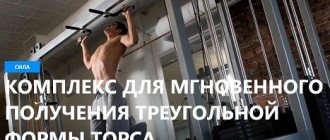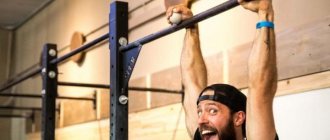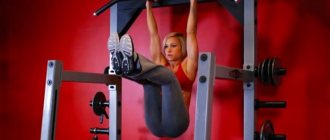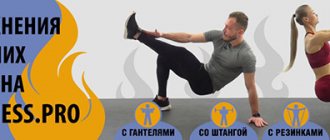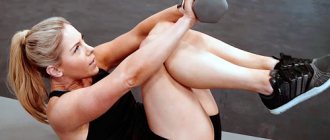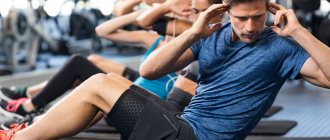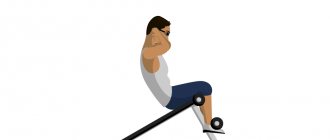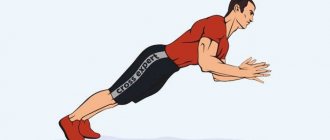How to do hanging leg raises
Oddly enough, to perform this exercise we will need a bar as for regular pull-ups. It is in every gym, in almost every yard, and half of us have it in our door frame. So there shouldn't be any problems with this.
So, grab the bar and straighten up completely. The height of the horizontal bar should be such that you do not touch the floor. You can get onto the crossbar by jumping, from a stool, or by climbing up the doorframe. Just kidding, of course, I'm just in a good mood.
We hang freely on the horizontal bar. The body is completely straight. The back should be slightly arched at the lower back. This is our starting position. Next, taking a deep breath and holding your breath, vigorously raise your legs up as high as possible. Then we slowly lower ourselves to the starting position. Then we do the next repetition. The legs are slightly bent at the knee joints throughout the entire approach.
If you raise your legs to approximately parallel, then mainly the lower abdominals are involved in the work. If you raise your legs high enough (some skilled people lift their legs until they touch the bar), then the pelvis flexes and the upper abdominals come into play.
In general, hanging leg raises are a universal exercise with which you can work all parts of the abdominal press, including its lateral areas. To do this, you need to change the angle of pelvic flexion and work the oblique muscles (i.e., turn the torso to the sides).
As a rule, it is difficult for novice athletes to perform this exercise with maximum amplitude. To make it easier to lift your legs while hanging, at the initial stage it is better to lift your legs with your knees bent at approximately a right angle.
Nuances and mistakes of hanging leg raises
As you can see, the exercise is quite simple, but nevertheless has a number of nuances. The first and main mistake of beginners is swaying their torso and throwing their legs up using cheating. There is no point in such a performance; on the contrary, we try to isolate the abdominal muscles as much as possible, and this is achieved with the correct technique. By the way, you can avoid this by performing the exercise on a wall bars or on a crossbar that is located close to the wall. In this case, your back will rest against the wall and the possibility of cheating will be practically eliminated.
Hanging leg raises, of course, are best used in combination with other exercises for the abdominal muscles, for example, with various types of crunches. It is necessary to train the abdominals at every workout, at the end of it. The abdominal muscles respond best to training when you do 20-25 repetitions in each approach. I do a set of crunches and leg raises, 3 sets of each exercise.
PS. By the way, I advise you to familiarize yourself with the nuances of the technique of basic exercises in video format.
Hanging Knee Raise
Grab the bar and hang on it:
- inhale and pull your knees as high as possible, trying to bring them closer to your chest by twisting your body, then return to the starting position;
- At the end of the movement, exhale.
This exercise uses:
- iliopsoas, sincere muscles of the thighs, tensor fasciae extensivea when climbing the legs;
- sincere abdominal muscles and at least the oblique muscles, sometimes you pull your knees to your chest. For the most isolated exercise of the abdominal muscles, do not lower your knees more than horizontal.
Abdominal-lumbar ratio
It is extremely important to measure the muscles of both the abdominals and the back, which straighten the spine. Lack of the necessary tension or excessive tension in one of these muscle groups can lead to an erroneous body position, which in the future can lead to a variety of pathologies.
Example:
Excessive tension in the back muscles that straighten the spine (sacrolumbar muscle mass), coupled with insufficient tension in the abdominal muscles, increases the curvature of the spine (anterior bending) and immediately prolapse of the internal organs of the tummy. From time to time, this deficiency, if it is not advanced, can be corrected with special exercises that strengthen the abdominal muscles.
On the contrary, excessive tension of the abdominal muscles, coupled with weakness of the spinal muscles that straighten the spine, especially in their higher parts (spinalis dorsi, longus dorsi, iliocostal dorsi), causes kyphosis of the thoracic spine and loss of lumbar curve. This deficiency can be corrected with special exercises that strengthen the muscles that straighten the spine.
Performance
- Grab the bar with a straight, medium grip and hang from it. Legs are down. This is the starting position.
- As you exhale, bending your knees, raise your hips as high as possible, trying to touch your chest.
- Slowly return to the starting position along the same path.
To put more stress on the lower abdominal muscles, keep your legs slightly bent at the knees in the lower position, and while raising your hips, try to lift your pelvis.
This exercise can be performed with straight legs. This way you will put maximum stress on the lower abdominal muscles. The exercise is performed on a special machine with a back support.
If you have difficulty supporting your own weight on the bar, then use special elbow support sleeves.
Hanging knee raise technique
Recommendations for implementation:
Raise your legs as high as possible. In the first phase of the exercise, the load mainly falls on the hip flexor muscles. The lower part of the press begins to contract from an angle of 30-45 degrees. The more you bend your knees, the lower the load on your abs and vice versa
Use this to adjust the intensity of your training. Please note that with strong quadriceps and good stretching, you need to raise your legs much higher while hanging.
Execution Features
There are several ways to perform hanging leg raises. They all differ in complexity and technique. Only trained athletes can perform the classic variation of hanging leg raises to the bar. For beginners, hanging knee raises or standing leg raises are more suitable.
To perform the “Hanging Leg Raise” exercise for the press, you only need to have at hand only a horizontal bar or crossbar of a suitable height. By the way, there is probably a horizontal bar in any gym or yard sports ground. Thanks to this, this exercise is accessible to almost everyone and is very popular among athletes. For convenience, you can buy a horizontal bar for the doorway and perform hanging leg raises even at home at any suitable time.
Using the “Hanging Leg Raise” abdominal exercise, you can perfectly pump up not only the rectus abdominis, but also the external oblique abdominal muscle. In addition, if you want to specifically pump up your lateral abs, I advise you to do hanging leg raises or hanging knee raises with knees rotated to the sides at the top of the range of motion.
Muscles involved
Many beginners are interested in which muscles work when they do hanging leg raises on the horizontal bar. First of all, like all exercises for training the abdominal muscles, hanging leg raises directly engage the abdominal muscles. Namely, the rectus abdominis and external oblique muscles. In addition, at the beginning of the movement, until the moment when you raise your legs 30-45 degrees, the leg muscles also work hard. First of all, these are the long adductor and rectus femoris muscles.
Then the entire load goes directly to the abdominal muscles. At that time, the forearms receive an indirect static load. Therefore, if you want to not only pump up your abs, but also strengthen your forearms and hands, then instead of the usual abdominal crunches, do hanging leg raises on the horizontal bar.
Execution technique
The technique of performing leg raises while hanging on a bar is very simple. First of all, you need to take the starting position - hanging on the bar with a straight grip slightly wider than shoulder width. Now you can start doing this exercise for the abdominal muscles. To do this, you need to use the force of the target muscles to raise your legs, slightly bent at the knees, to the level of the crossbar or at least above parallel with the floor. After going through the most difficult part of the range of motion, exhale.
Then, keeping tension in your abdominal muscles, lower your legs down while inhaling. The main task is to prevent the body from swaying while hanging on the horizontal bar and to raise not only your legs, but also lift your pelvis up, while rounding your back, as when doing abdominal crunches. This is the only way to pump up your abdominal muscles as effectively as possible.
Recommendations and common mistakes
- When performing the Hanging Leg Raise abdominal exercise, do not swing your legs back and forth to avoid inertia and dissipate the load throughout your body. Remember, if you want to pump up your abdominal muscles, you need to concentrate on working the target muscles, that is, the abdominal muscles.
- The height of the crossbar or horizontal bar should be such that your feet lightly touch or do not touch the floor at all.
- To increase the load on your abdominal muscles, try to keep your legs together during the exercise.
- At the top phase of the movement, try to lift your pelvis up, as when doing a crunch. Only in this position does contraction and development of the abdominal muscles occur most effectively.
- When performing hanging leg raises to the bar, do not try to do pull-ups or bend your elbows. Your arms should remain straight throughout the entire approach. You can move your pelvis forward slightly so that your abdominal muscles maintain constant tension.
- To get six-pack abs, perform hanging leg raises twice a week at the end of your workout. Do 3-4 sets until failure occurs due to a hellish burning sensation in the abdominal muscles.
- Leg raises while hanging on the bar are complex abdominal exercises that can be performed by trained athletes with strong core muscles. Therefore, as a rule, leg lifts are performed without additional weights. However, if you were able to easily complete 3-4 sets of 20 repetitions, then you can use special leg weights as additional weight. This will allow you to further increase the workload on your abdominal muscles.
- If you have a weak grip, use special wrist straps or perform leg raises on a machine.
Execution options
Raising the knees while resting on the elbows
This version of the exercise is suitable for beginners and those who find it difficult to lift their straight legs up. It is anatomically simpler, as it is easier to understand how to bring the hips to the ribs if the legs are bent. The athlete takes the starting position similar to the previous option, and then carefully pulls the pelvic bones to the lower ribs. Lowering is also smooth. There is no need to straighten your knees with each repetition.
Side leg raises
This is the same gymnastic exercise that imitates a fitness option. For fitness purposes, you do not need to learn to throw your legs with your toes pointed up due to inertia and rotation in the shoulder joints. Here you need to carefully pull up your straightened legs with your toes pulled slightly above the midline of the body, and just as carefully lower the entire “structure” back.
Leg raises supported by parallel bars
This option is intended for those who want to pump up their oblique muscles. Here you need to pull your knees to your waist, but “obliquely”, aiming your knees first to one or the other shoulder.
Leg raises: 3 difficulty options
Typical beginner mistakes
Many abdominal exercises have their own technical nuances that you need to master in order to get the most out of them. Let's look at the most common mistakes, myths and misconceptions:
- You should not train your abs more than 1-2 times a week. Crunches are a fairly easy exercise, but even after it the body needs time to recover.
- By performing a large number of repetitions, you will not burn excess fat deposits on your stomach and get the coveted “cubes”. The optimal repetition range for crunches is 12-20; in combination with a diet tailored to your goals, this approach will give maximum results.
- Do not use too heavy a weight. If you do crunches with a disc or dumbbell, do not chase the weights, it is better to focus on mental concentration and contract the abdominal muscles more isolated, but involving no assistant muscles in the work.
How to pump up your abs with oblique crunches
This exercise targets the oblique abdominal muscles. It serves as a basic exercise. By doing this exercise you can strengthen your abs and significantly highlight your waist. In the development of abdominal muscles, the oblique crunch exercise plays a significant role.
Technique for this exercise
You need to lie down and bend your knees. Then turn onto your side. The knee should touch the floor.
One hand needs to be placed behind the head. Place the other on your thigh.
After inhaling and holding your breath, tighten your oblique abdominal muscles and try to bend in half, while pointing your shoulders and head straight up and forward.
When, from the starting position lying down, the shoulder on which you were lying lifts a couple of centimeters from the floor, exhale and return to the starting position.
After completing all the reps on one side, do the same number of reps on the other side.
It is important that the hips continue to remain rotated 90° in relation to the body.
Application. This exercise is mainly intended for athletes with an average level of training. It should be performed at the end of the abdominal muscle workout. Do 3-4 sets. Reps 10-25
How to pump up your abs with the basic reverse crunch exercise
This exercise targets the lower abs. It is basic. Helps increase strength and strengthen the lower abs.
Technique for this exercise
Lie on your back and extend your arms along your torso. With your knees bent, raise your hips until they are perpendicular to the floor.
After inhaling and holding your breath, tighten your abs and pull your knees towards your chest. The knees at the top point should be pulled as close to the chest as possible. The pelvis at the top point should be completely lifted off the floor. When you reach the top, exhale.
If it is difficult to lift your hips off the floor, then at the beginning of the set, help yourself a little with your hands. To do this, you can rest your hands on the floor.
There is another important point in this exercise. You should try not to straighten your legs during crunches. Otherwise, you may be tempted to complete the repetition by pushing your leg muscles. This makes the exercise less effective.
Application
This exercise is for everyone. Both beginner and master. It is basic in abdominal training. This can be done as the first in a series of exercises for the abdominal muscles.
Do 2-4 sets. Reps 10-25
Ratings
- 5 simple rules for getting your child to eat (10.00 out of 5)
- What to talk about with a girl when you're walking down the street (10.00 out of 5)
- Which is better: a well or a borehole for a home? (10.00 out of 5)
- Vascular dystonia: its symptoms and danger (10.00 out of 5)
Bent-legged hip raise[edit | edit code]
Source:
“Bodybuilding.
Book trainer" .
Editor:
Oksana Usoltseva
Ed.
: Eksmo 2013
Inventory
: fitball, gymnastic mat.
Core muscles
: hamstrings, buttocks, abs, cadriceps.
Additional muscles
: psoas, rhomboid, teres dorsi.
Level of training
: average.
Step 1
. Lying on your back, bend your legs at an angle of 90°. Your shins should be parallel to the floor. The feet lie on a fitball.
Step 2
. Keeping your abs tight, lift your hips until your body is straight.
Step 3
. Hold the position for a few seconds and then slowly lower to the floor.
Legs bent at the knees put additional stress on the quadriceps. Straight legs reduce the load by more actively engaging the muscles of the back and buttocks.
Complex training on simulators and multi-span gymnastic equipment
Complex training is carried out with the aim of increasing the density of the lesson, improving the physical qualities and military-applied motor skills of the trainees. Its content includes previously studied program exercises, techniques and actions, as well as exercises on simulators and multi-span gymnastic apparatus.
The training is organized in a group or frontal manner.
In the group method, the unit is lined up in a column of three (four, etc.). The commander, having indicated the training places, gives the command: “MARCH to the training places by walking (running).” At this command, the squads move forward along the shortest route to the training areas, position themselves so that the indicated places are to the left of the formation, and indicate a step in place. Then, on a general command, they stop and turn left. The commander gives the command: “GET TO THE EXERCISES.” The squad leaders go to the middle of the formation, turn to face the unit, name the exercise being performed and give the command “FREE” (“Gymnastic stance - ACCEPT”) and supervise the training of their subordinates. To change training locations, the leader gives a command, for example, “Platoon, exercise - FINISH.” At this command, the students stop doing the exercises and line up in one line. Changing places of training is carried out using the commands: “Headward-VO”, “To change places of training by walking (running) - MARCH.” At the first shift, the transition order is indicated.
With the frontal method, the commander determines the first training place and gives the command: “To the place of training, step (run) - MARCH.” the unit moves forward along the shortest route to the specified location, stops at the commands of the leader and turns left. After completing the exercises, the unit moves to the second training location, then to the third, etc.
| Exercises on a gymnastic bench | |
| Perform on a gymnastic bench simultaneously with the entire unit for the maximum number of times |
| Exercises on a multi-span bar | |
| Perform on a multi-span bar in pairs with assistance, for the maximum number of times |
| Exercises on multi-span bars | |
| Perform on multi-span bars simultaneously with the entire unit, for the maximum number of times. Walk on the uneven bars on your hands to the distance specified by the leader. |
| Exercises with weights | |
| Perform using multi-span cargo simultaneously by the entire unit or based on the number of cargo for the maximum number of times |
It is advisable to carry out training in performing strength exercises on simulators and multi-span apparatus using the repeated method or the method of maximum effort. The number of repetitions of the exercise in one approach depends on the level of the current individual indicators of the student, which must be recorded by the commander.
Repetitive training consists of repeating an exercise many times with the same power (the amount of effort should be no more than 60 percent of the maximum).
Training using the maximum effort method is carried out after 3-4 training sessions using the repeated method. In training, when the practitioner performs an exercise with maximum effort, it is sometimes advisable to provide assistance in the final stage of the approach in order to overcome the psychological barrier of a certain number of repetitions. You should not stop at the achieved results. It is always necessary to create a reserve of motor abilities, guaranteeing the necessary level of preparedness.
The maximum effort method is characterized by performing exercises in which the soldier exhibits the maximum strength of which he is currently capable. Maximum effort refers to the maximum resistance training weight that a student can lift (perform) without significant emotional arousal.
Execution technique
Don't try to keep your legs straight. It is necessary that your knees are slightly bent. This is done to avoid injury to the knee joints. If it is difficult for you to raise your legs straight, then raise your legs in a position where they are bent at the knees to an angle of approximately 90 degrees. Over time, when your muscles get stronger, you can gradually straighten your legs and then do the exercise with straight legs.
And if you didn’t have enough time for the third approach, then either do as much as you can, or supplement with the exercise “Lifting legs while lying on the floor,” on a bench, on any machine on which you can perform leg lifts while lying down. Breathing is the same as when lifting your legs while lying down, that is, when lifting your legs up, you need to exhale, and when lowering, inhale.
Leg raises can be performed hanging on a wall bars or on any other machine. This can be either an inclined board or any machine designed to perform this exercise.
Sets and reps
The principle of selecting the number of approaches and repetitions in these approaches remains as follows: in the first approach, you perform such a number of repetitions as to load your muscles to 60 or 70% of their maximum capabilities.
In the second approach, perform as many repetitions as possible. Well, in the third - how it turns out. In the future, you try to gradually increase the number of repetitions in all approaches. At least one repetition in one or even several classes. Then, when your muscles are strong enough, you can use weights.
Exercise technique
small bench
At the top point, tighten your abdominal muscles as much as possible and hold in this position for 1-2 seconds. Exhale and lower your legs to the starting position, relaxing a little. After a short pause, repeat the exercise.
After fully mastering the technique, you can complicate the exercise: perform straight leg raises. At the same time, the load will increase both on the hip flexor muscles and on the lower part of the abs.
Recommendations
Start learning the exercise by lifting your legs, while bending them at the knees. But as you gain experience, do the exercise at a more advanced level - raise your legs while fixing the angle at your knees. Don't be embarrassed by the fact that this exercise works your hip flexors, as they are involved in all abdominal exercises. It is simply impossible to ensure that the load goes only to the abdominal muscles, without using the hip flexor muscles!
The legs in this exercise play the role of a lever, the length of which sets the level of load. To increase the load, you just need to straighten your legs more. If your quadriceps are strong enough and your hamstrings are elastic (stretch well), then to engage your abdominal muscles you will need to raise your knees much higher than your waist.
Notes[edit | edit code]
Abdominal muscles
Raising bent legs while lying on your back is a simple but very useful exercise that teaches you to purposefully control the actions of the muscles, primarily the abdominal muscles, in order to maintain a stationary position of the torso while making movements of the lower extremities.
Stabilization of the torso when bending the leg at the hip joint. When lifting bent legs while lying on your back, the abdominal muscles do not move, but act as stabilizers. Because many of the muscles that flex the leg at the hip joint are attached at the top to the lower spine and the front of the pelvis, their strong contraction when lifting the leg can cause the lower back to sag and the pelvis to tilt forward. These movements should be counteracted by the abdominal muscles.
Research shows that the transverse abdominis muscles play an extremely important role in stabilizing the torso during limb movements. The fibers of the transverse abdominis muscle are almost horizontal, so by pulling the anterior wall of the abdominal cavity towards the spine, you activate this muscle, which allows you to maintain a neutral pelvic position.
The ability to use the abdominal muscles and other core muscles to stabilize the torso is considered one of the main goals of Pilates, as this ensures the correct execution of many other more complex exercises, such as Die Hard.
Monthly training program
The Internet is replete with a huge number of training programs for the press.
“Abs in a week”, “Abs in 7 minutes a day” and other nonsense that you shouldn’t waste your attention on. Below I propose a working program for the development of abdominal muscles, designed for a month (4 training weeks), the basis of which is various types of twisting
You can use it if you want to improve your muscle definition, make your abdominal muscles stronger and increase the number of repetitions you can perform without technical errors. The program is built on the principle of periodization, alternating heavy and light workouts. Within one week we do one heavy volume workout (for example, on Monday), and three days later (on Thursday) we do a lighter workout to keep our muscles toned. In total, there are eight workouts in a month.
| Workout number | Type of workout | Exercises |
| 1 | Heavy | 1. Hanging leg raises: 4 sets of 10-15 reps. 2. Crunches lying on the floor: 3 sets of 15-20 repetitions. 3. Plank: 3 sets of 45-90 seconds. |
| 2 | Lightweight | 1. Crunches lying on an incline bench: 3 sets of 12-15 repetitions. 2. Crunches in a block machine while standing on your knees: 2 sets of 10-12 repetitions. |
| 3 | Heavy | 1. Crunches while lying on an inclined bench with additional weights: 3 sets of 10-12 times. 2. Oblique crunches: 4 sets of 12-15 repetitions. 3. Plank: 3 sets of 60-90 seconds. |
| 4 | Lightweight | 1. Crunches lying on the floor: 5 sets of 10-15 repetitions. |
| 5 | Heavy | 1. Crunches while lying on an inclined bench with additional weights: 3 sets of 12-15 times. 2. Sit-ups: 3 sets of 10-12 reps. 3. Plank: 3 sets of 75-90 seconds. |
| 6 | Lightweight | 1. Crunches lying on the floor: 3 sets of 10-12 repetitions. 2. Reverse crunches: 2 sets of 12-15 reps. |
| 7 | Heavy | 1. Crunches while lying on an inclined bench with additional weights: 3 sets of 15-20 times. 2. Sit-ups with additional weights: 3 sets of 10 times. 3. Plank: 3 sets of 90-120 seconds. |
| 8 | Lightweight | 1. Crunches lying on the floor: 3 rounds of 12-15 repetitions. |
Author
Training experience – more than 8 years. Winner and medalist of All-Russian powerlifting and deadlift tournaments. Candidate for Master of Sports in deadlift.
Lying leg raise technique, variations, important points
Exercises
The most common problem on the way to an attractive flat stomach is the fat layer in the lower abdomen. It can spoil the appearance even of avid athletes who have visible abs in the upper sections. But it’s a little more difficult to work on the lower abdomen. An exercise with leg raises while lying on your back is ideal for pumping the lower abdomen. How to do it correctly - read below.
Lifting your legs while lying down can be done simply on the floor on a mat, on an inclined bench. This exercise is well suited for beginner athletes because it is a lighter version of hanging leg raises. Since it does not require a special tool, it can be done at any time and in any circumstances. The abdominal muscles work by lifting their own weight.
What does the exercise do?
The lying leg raise exercise is aimed at:
- strengthening the abdominal muscles;
- increasing endurance and strength load of the abdominal press;
- prevention of osteochondrosis and intervertebral hernias;
- increasing the overall tone of the body as a morning exercise.
Depending on the physical activity, the exercise can be performed in different variations. For example, it will be easier for beginners to do alternating leg raises while lying on the mat.
Execution Variations
The starting position is this. The back is pressed tightly to the floor, there is no deflection in the lower back. Hands lie along the body.
First, we raise one leg to a level of 45-60 degrees, fix the position a little and lower the leg. As soon as the first leg touches the floor, the second one rises to the specified level. We exhale while lifting, inhale while lowering the limbs. You can start with 2 sets of 10 times on each leg.
An exercise of medium difficulty looks like this. The starting position is the same, legs together. Raise both legs to 45-60 degrees, hold in this position for 1-2 seconds and lower.
To complicate such lifts, you can not lower your heels to the floor, but keep your legs slightly suspended. Then the abs will be tense all the time throughout the entire exercise. We perform 2-3 sets of 10-15 repetitions, over time increasing the number of repetitions to 30 on each leg.
A more complicated version of leg lifts in a lying position is performed with weights. But if you are just starting to play sports, do not immediately resort to complex variations of the exercise.
Increase the difficulty gradually as your abs develop. The exercise technique remains the same, but a weight is attached to each leg. Its weight varies according to your desire and health status.
Helpful advice: remember that when you raise your legs above 60 degrees or below 45, the load on the abs is lost.
What are the errors?
The following mistakes are often encountered when performing lying leg raises:
- separation of the body following the limbs;
- classes on a cold floor without a mat;
- lifting legs with jerks;
- no fixation in the raised position of the legs;
- sudden throwing of legs down;
- do not exercise on a full stomach; wait at least one hour after eating.
You can watch how to perform lying leg raises in the video below.
This is interesting: Traction of the upper block - we describe it point by point
Analysis of the exercise
Anatomy of exercise - which muscles work
Main muscles involved:
Auxiliary muscles: muscles - hip flexors (mainly the iliopsoas muscles, to a lesser extent the pectineus and rectus femoris), and static muscles of the shoulder girdle (trapezius, triceps and forearms).
Advantages
Flaws
Preparation for execution
Start your training with a classic warm-up, including “warm-up” aerobic exercise, dynamic stretching, and joint exercises.
Additionally, before lifting, perform several sets of bends to the floor with straight knees to stretch the ligaments.
Proper execution
Errors
Performance Recommendations
Inclusion in the program
The “sequence” of the exercise is not important - lifts can be performed at the beginning, end or middle of the workout, depending on the overall work plan and goals. The only condition: it is not recommended to heavily load the abdominal muscles before performing basic exercises with heavy weights.
The most acceptable repetition range for this exercise is from 15 to 20. Athletes who can easily perform this amount of work should resort to using additional weight.
Beginners for whom the exercise is inaccessible due to insufficient preparedness should start with standard leg raises on an inclined bench or a variation with bent knees.
Contraindications
Interesting Facts
Mike Francois, who won gold in the Arnold Classic championship in 1995, calls leg raises the most powerful and effective abdominal exercise.
At the same time, he notes that the best effect is obtained by constantly changing training modes for performing lifts: volumetric work without weight and training with weights in an average number of repetitions.
Alternatives
Technique for performing leg raises
Next, we will analyze the correct technique for performing the exercise.
- Starting position: rest on your elbows and forearms in a training rack. Press your back firmly against the back of the machine. Firmly grasp the special handles with your hands. The position of the upper body should be fixed; do not fall down, raising your shoulders and pulling your head into them.
- From the above position, as you exhale, powerfully lift your legs as high as possible, above parallel with the floor. At the initial stage of the exercise, you can do lifts with slightly bent legs, but keep them in a fixed position. For maximum efficiency at the top of the amplitude, try to slightly twist your pelvis forward. Hold at the peak point for one second.
- Smoothly exhale, without lowering your legs sharply down, take the starting position. Keep your abdominal muscles tense throughout the entire approach.
Perform 3-4 sets of 10-15 repetitions
Please note that straight legs are more difficult to lift than bent knees.
On the uneven bars, the exercise is performed in a similar way, with the difference that the emphasis is placed on the uneven bars with outstretched straight arms. As in the first option, the upper body is rigidly fixed, the back is kept straight, and when lifted into the pelvis, it is slightly tucked forward. Your arms should be well developed, since on the uneven bars the muscles of the arms perform the functions of supporting and supporting the torso, as well as stabilizing the position during leg lifts.
Just like in the simulator, lifting the legs occurs while exhaling, and lowering them while inhaling. At the top point of the amplitude, fix the position of the legs for 1 second.
When performing leg raises on parallel bars, there is a desire to move your legs back a little before performing the next lift. On the one hand, such a small cheat will allow us to overcome the lower stage of the lift and eliminate the load on the hip flexor muscles, which we do not need in this exercise. On the other hand, strong use of inertia will greatly facilitate the exercise, and therefore make it less effective.
Tips and common mistakes
In fact, the name of the exercise is a little misleading to people, because just doing leg raises will work mainly the leg muscles, the iliopsoas muscle, and the abdominal muscles will not receive enough load for their development. The most important motor function of the abdominal muscles is to bring the upper torso to the lower, that is, the chest to the pelvis and, conversely, the lower to the upper.
Therefore, in order to work the abdominal muscles, you definitely need to lift your pelvis from the back and twist it upward.
It is also common for beginners to lift their legs with their legs fully extended, which can put negative stress on the lower back, especially for people with little training experience who may be at risk for injury or pain. Thus, for beginners, it is better to keep your knees in a slightly bent, fixed position.
To increase the load as you gain training experience, you can use additional weights in the form of weights that are attached to your legs, or dumbbells held between your legs. You can also use a technique where your partner will lightly hold your legs while lifting, thereby increasing the degree of load.
Conclusion
Raising your legs while resting on your elbows, when performed regularly, allows you to give strength and definition to your abdominal muscles, as well as maintain the tone of your abdominal cavity.
This exercise is perfect for both men and women, both experienced athletes and beginners. To fully work out your abdominal muscles, combine it with crunches, sit-ups, or other abdominal exercises.
Working muscles
First, let's talk about the group of muscles that are used during training.
Basic
During the exercise, the rectus and oblique abdominal muscles are activated.
It is worth understanding that these muscles bear the main load, so we classify them as the main ones.
Additional
Additional ones include those that are indirectly involved in one way or another when performing the exercise and to which the largest part of the load is distributed. That is, they will also swing, but less intensely.
Additional muscles include the rectus femoris and iliopsoas muscles.
The muscles described above are used when performing the exercise on a special simulator. If you do not use such equipment, then the arm muscles may be involved in the training process.
